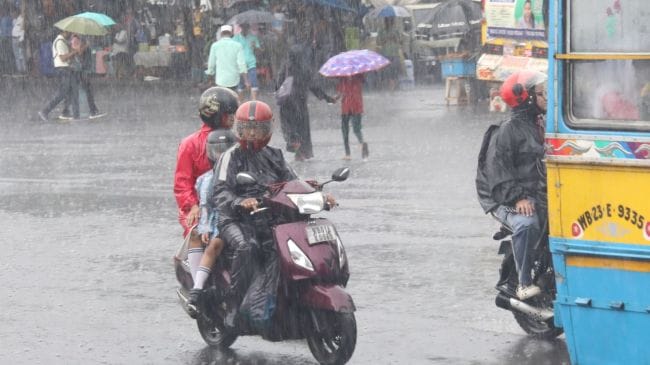Opinion From Mrinal Sen’s films to today’s reality: Lives of Bengal’s poor in face of torrential rain have hardly changed
The indignity that Sen once associated with the poor in the face of disaster has resurfaced in recent tragedies
 For instance, the IMD forecast for June in Kolkata indicated rainfall intensity of 20–30 mm per hour, potentially causing waterlogging. (Express Photo)
For instance, the IMD forecast for June in Kolkata indicated rainfall intensity of 20–30 mm per hour, potentially causing waterlogging. (Express Photo) Written by Prasenjit Sarkhel
This monsoon, the rainfall in South Bengal far exceeded the average, resulting in frequent downpours and an overcast sky. Instead of evoking classical musings or poetic rhythms, the pattering rains revived memories of Mrinal Sen’s Kolkata 71, particularly the segment based on Manik Bandopadhyay’s Atmohatyar Odhikar (The Right to Self-Immolation). In that part, Sen portrays the plight of a family trapped in their leaking shack on a stormy night. With four children, including an infant, they struggle in the rain, refusing to seek refuge in the house of their wealthier neighbour. Eventually, the relentless downpour seeps through the dilapidated roof, stripping them of pride and forcing them to join the displaced crowd huddled in the portico of the Sarkars, their neighbour.
From the inundated alleys of the city to the flooded fields of rural areas, much of Bengal’s monsoon mirrored the plight Sen captured on celluloid more than half a century ago. Many attribute this to climate change, but policymakers rarely admit the more immediate truth: A lack of preparedness to mitigate weather shocks.
Ironically, “Sarkar” – not as a surname but as government — has a central role in disaster management. In today’s era of decentralised governance, it is indeed the state that is expected to reach out, particularly to the vulnerable in times of disaster. The effectiveness of the state can be measured by the swiftness with which disaster assistance reaches them. Yet the prolonged entrapment of people in inundated neighbourhoods shows that public capacity for relief has been, at best, limited.
This inadequacy was tragically visible in a recent incident. In Sen’s film, the mother shields her infant from the rain, but in today’s city, a five-month-old baby drowned on the flooded floor of a slum dwelling in the North Dum Dum area in August, slipping past the increasingly weary mother’s vigilance.
In congruence with Sen’s depiction of drudgery, many of the worst-affected waterlogged areas belong to non-notified slums. An NSSO survey in 2013 revealed that West Bengal has the second-highest proportion of such slums in India (14 per cent). These unregistered settlements are a natural by-product of high-rise-driven urbanisation. The labour that sustains the comfort of gated communities, such as domestic workers and cleaners, comes from these ramshackle clusters. In exchange, local political leaders demand their support, while the provision of potable water and sanitation, let alone flood protection in these habitations, rarely makes its way onto the planning and development agenda. Essential infrastructure remains deficient, and the divide between residents and public assistance widens further in times of disaster.
The larger the number of unregistered settlements without drainage and sanitation, the greater the chance of waste being dumped into outlet channels, clogging the sewage system and heightening flood risks. In many cities, stormwater drains are designed to flush out rainfall at 12–20 mm per hour, which is inadequate by current standards. For instance, the IMD forecast for June in Kolkata indicated rainfall intensity of 20–30 mm per hour, potentially causing waterlogging. Drainage networks also suffer from limited coverage, as they do not extend to all neighbourhoods, and existing drains are too narrow to handle sudden cloudbursts. Unless long-term planning expands and upgrades these networks, floodwaters will continue to stagnate, isolating the poor.
If urban floods stem mainly from inadequate sanitation systems, rural floods are amplified by derelict transport infrastructure. Wyatt Brooks (Arizona State University) and Kevin Donovan (Yale) found that stable bridges in Nicaraguan villages mitigate the economic costs of flooding. A simple footbridge can offset nearly one-fifth of the income loss caused by floods. In India, however, the absence of rural bridges often cuts villages off from safety.
Overhauling stormwater drainage in cities and rebuilding rural bridges are time- and fund-intensive undertakings. As an immediate measure, however, the government must ensure that local authorities respond swiftly to early warnings from the India Meteorological Department (IMD). In collaboration with the Indian Space Research Organisation (ISRO), the IMD has improved forecasts of localised rainfall and cloudbursts. Yet these alerts achieve little unless they trigger timely action. Evacuation is rarely attempted in waterlogged areas, even though residents could be temporarily shifted to shelter homes, such as those used during the COVID-19 pandemic. Instead, civic authorities often wait passively for the waters to recede, shifting the entire burden of coping onto the poor who inhabit the most fragile locations.
The indignity that Sen once associated with the poor in the face of disaster has resurfaced in these recent tragedies. Unless civic authorities confront the urgent task of strengthening flood infrastructure, the path to Sarkar’s safe house will remain perilous, leaving the vulnerable trapped in an endless cycle of indignity and loss whenever the rains arrive.
The writer is Professor of Economics, Kalyani University





